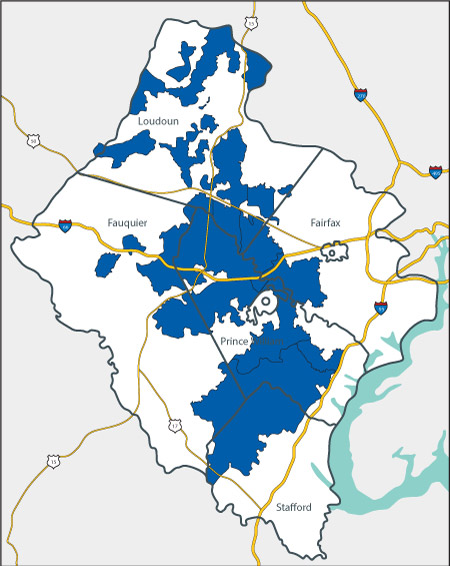
Northern Virginia Electric Cooperative service territory
Source: Northern Virginia Electric Cooperative, Who We Are

Northern Virginia Electric Cooperative service territory
Source: Northern Virginia Electric Cooperative, Who We Are
The Northern Virginia Electric Cooperative started as two separate organizations. They merged in 1983, creating the Northern Virginia Electric Cooperative.
The Tri-County Electric Cooperative started in 1939. It originally contracted with the Bull Run Power Company to purchase electricity at wholesale rates, then built a distribution system and handled billing for its retail customers. The cooperative began purchasing electricity from Virginia Electric & Power Company (now Dominion Energy) in 1947.
The Prince William Electric Cooperative started in 1941, when it purchased the Bull Run Power Company. Funding for both of the cooperatives' infrastructure came from low-cost loans provided by the Rural Electrification Administration in the US Department of Agriculture.
For additional and more reliable energy beyond the hydropower on Bull Run, Prince William Electric Cooperative built a 440kW (kilowatt) power plant on Route 28. After World War II, the number of customers increased. The cooperative added more diesel generators to meet increasing demand.
The investor-owned Virginia Electric & Power Company recognized the potential for profit as the Washington suburbs expanded, but the Prince William Electric Cooperative declined an offer to sell out to the private corporation.
Virginia Electric & Power Company then offered to sell electricity to the Prince William Electric Cooperative at a rate cheaper than the cost of generating it with diesel engines. Old Dominion Electric Cooperative also offered to be the wholesale provider, but Virginia Electric & Power Company offered a better rate in order to limit competition. Signing the contract with the private utility allowed the Prince William Electric Cooperative to focus on distribution and billing, and to stop generating electricity.
In the 1966 Annual Report, the president of the cooperative noted:1
Tri-County Electric Cooperative had a different experience. In the 1970's, it had too few customers in its service area of western Fairfax County, Loudoun County, and Clarke County. Costs escalated faster than revenues, and the Rural Electrification Administration demanded that the co-op merge with a partner to become financially stable. Talks with Prince William Electric Cooperative started in 1979, and concluded with a merger in 1983 to create the Northern Virginia Electric Cooperative.
In 1971, the Prince William Electric Cooperative had 16,000 customers. Between 1983-1880, the number of customers for the two merged cooperatives swelled from 38,000 to 70,000. Rapid suburbanization continued, and by 2008 the number of customers had reached 140,000. To minimize peak demand and reduce the costs paid for wholesale power, the co-op implemented a Load Management Program to cut off power for brief moments to water heaters and central air conditioners. All customers received the benefits of shaving off the peak demand:2
By reducing the amount of power consumed during peak periods, NOVEC can reduce its total wholesale power costs. Reductions or increases in these expenses are passed directly on to customers each month through the power cost adjustment
NOVEC purchased power from the Old Dominion Electric Cooperative until 2008. Virginia's efforts to deregulate the electrical generation market failed, but after 2000 NOVEC calculated that it could purchase wholesale electricity from other sources at a better price. Virginia Power could generate more electricity than its retail customers demanded, and the PJM Power Pool offered a mechanism to purchase electricity from independent "merchant" generators.
NOVEC declined to commit to a new Old Dominion Electric Cooperative contract lasting into 2053. It negotiated a withdrawal from the wholesale cooperative in 2008, leaving Old Dominion Electric Cooperative with just 11 members. NOVEC now purchases its electricity through the PJM Energy Market.3